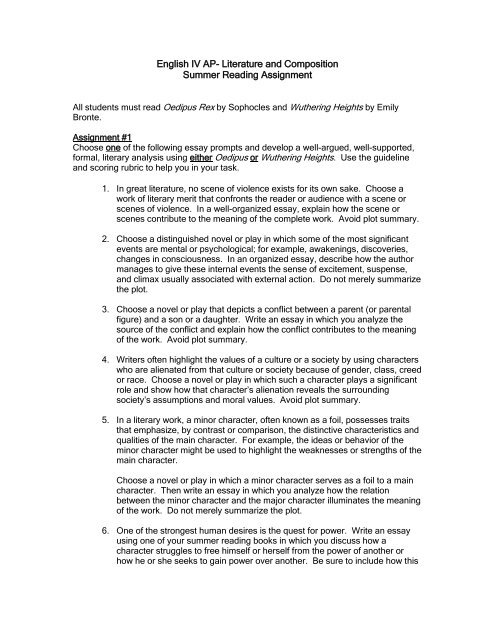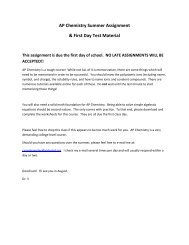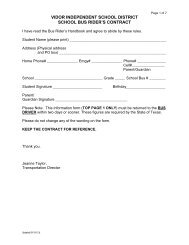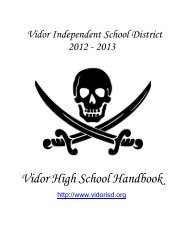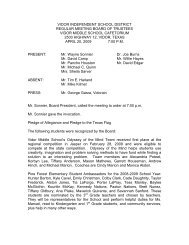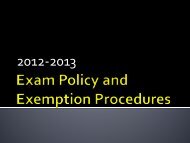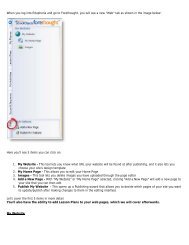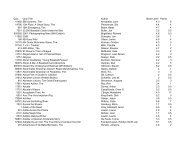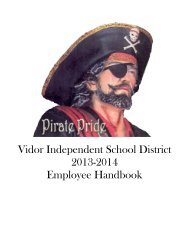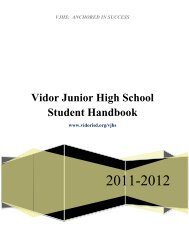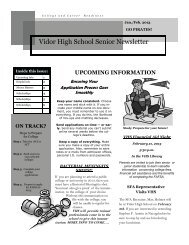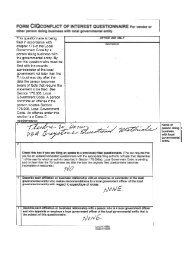English IV AP- Literature and Composition
English IV AP- Literature and Composition
English IV AP- Literature and Composition
You also want an ePaper? Increase the reach of your titles
YUMPU automatically turns print PDFs into web optimized ePapers that Google loves.
<strong>English</strong> <strong>IV</strong> <strong>AP</strong>- <strong>Literature</strong> <strong>and</strong> <strong>Composition</strong><br />
Summer Reading Assignment<br />
All students must read Oedipus Rex by Sophocles <strong>and</strong> Wuthering Heights by Emily<br />
Bronte.<br />
Assignment #1<br />
Choose one of the following essay prompts <strong>and</strong> develop a well-argued, well-supported,<br />
formal, literary analysis using either Oedipus or Wuthering Heights. Use the guideline<br />
<strong>and</strong> scoring rubric to help you in your task.<br />
1. In great literature, no scene of violence exists for its own sake. Choose a<br />
work of literary merit that confronts the reader or audience with a scene or<br />
scenes of violence. In a well-organized essay, explain how the scene or<br />
scenes contribute to the meaning of the complete work. Avoid plot summary.<br />
2. Choose a distinguished novel or play in which some of the most significant<br />
events are mental or psychological; for example, awakenings, discoveries,<br />
changes in consciousness. In an organized essay, describe how the author<br />
manages to give these internal events the sense of excitement, suspense,<br />
<strong>and</strong> climax usually associated with external action. Do not merely summarize<br />
the plot.<br />
3. Choose a novel or play that depicts a conflict between a parent (or parental<br />
figure) <strong>and</strong> a son or a daughter. Write an essay in which you analyze the<br />
source of the conflict <strong>and</strong> explain how the conflict contributes to the meaning<br />
of the work. Avoid plot summary.<br />
4. Writers often highlight the values of a culture or a society by using characters<br />
who are alienated from that culture or society because of gender, class, creed<br />
or race. Choose a novel or play in which such a character plays a significant<br />
role <strong>and</strong> show how that character’s alienation reveals the surrounding<br />
society’s assumptions <strong>and</strong> moral values. Avoid plot summary.<br />
5. In a literary work, a minor character, often known as a foil, possesses traits<br />
that emphasize, by contrast or comparison, the distinctive characteristics <strong>and</strong><br />
qualities of the main character. For example, the ideas or behavior of the<br />
minor character might be used to highlight the weaknesses or strengths of the<br />
main character.<br />
Choose a novel or play in which a minor character serves as a foil to a main<br />
character. Then write an essay in which you analyze how the relation<br />
between the minor character <strong>and</strong> the major character illuminates the meaning<br />
of the work. Do not merely summarize the plot.<br />
6. One of the strongest human desires is the quest for power. Write an essay<br />
using one of your summer reading books in which you discuss how a<br />
character struggles to free himself or herself from the power of another or<br />
how he or she seeks to gain power over another. Be sure to include how this
power struggle enhances the overall meaning of the work. Avoid plot<br />
summary.<br />
Guidelines for <strong>AP</strong> essay writing<br />
Your essay should:<br />
*…introduce the full name of the author <strong>and</strong> title of the work (in italics)<br />
*…use the author’s last name for the remainder of the paper<br />
*…make an assertion or state a claim as a controlling idea for the paper (a thesis)<br />
*…use some of the language of the prompt in your opening paragraph (do not simply<br />
restate the prompt)<br />
*…use specific details <strong>and</strong> examples from the book in your supporting paragraphs (cited<br />
in correct MLA format) <strong>and</strong> explanations of how the specific details prove your thesis<br />
*…create strong transitions between sentences <strong>and</strong> paragraphs<br />
*…not include plot summary<br />
*…eliminate personal tone (“I think…” or “In my opinion…” for example)<br />
*…form a conclusion to demonstrate that you have proven your thesis<br />
*…include a Works Cited page- typed to MLA st<strong>and</strong>ards<br />
*…be edited <strong>and</strong> proofread carefully- you are accountable for mechanics <strong>and</strong> grammar<br />
*…3 pages in length, double spaced, Times New Roman, 12 point font. No creative<br />
margins, fonts or cover sheets.<br />
Neglect to acknowledge indebtedness for facts, ideas, or expression<br />
will be interpreted as plagiarism. There are no exceptions to this rule.<br />
"Plagiarism" is a word defined from the Latin term for "kidnapper." Plagiarism<br />
involves taking someone else's words or ideas <strong>and</strong> pretending that they are your<br />
own. It is literary theft. If you are unsure about whether or not you need to<br />
acknowledge a source in your writing, it is better to be safe than sorry<br />
Assignment #2:<br />
Complete the Major Works Data Sheet for the summer reading book NOT used for<br />
assignment number 1. Be sure to read the directions for each section. You also need to<br />
include source information for historical <strong>and</strong> biographical information. DO NOT use<br />
sources such as Sparknotes, etc. This is to be your own work.<br />
(Insert data sheet template here)<br />
Both of these assignments will be due the first day of class. You will also have a test<br />
over each work the first two days of class.
Major Works Data Sheet<br />
Name__________________________<br />
2012-2013 Per:______ Date:____________<br />
The numbers in parenthesis represent the point values for each requirement.<br />
Title:___________________________ (1)<br />
Biographical information about the author: (3)<br />
Author:_________________________ (1)<br />
Date of Publication:_______________ (1)<br />
Genre: __________________________ (1)<br />
Historical information about the period of publication:<br />
(3)<br />
Characteristics of the genre: (3)<br />
Plot summary: (3)
Major Works Data Sheet Page 2<br />
Describe the author’s style: (7)<br />
Identify an example passage that demonstrates the style. Explain the<br />
example if necessary. (Please include a page number): (7)<br />
Significant Quotes (10)<br />
(Choose at least five <strong>and</strong> include page numbers. Quotes should demonstrate the range of the entire work.)<br />
Quote<br />
Significance
Major Works Data Sheet Page 3<br />
Significant Characters (10)<br />
Name Role in the story Significance Adjectives
Major Works Data Sheet Page 4<br />
Setting <strong>and</strong> significance (Please list <strong>and</strong> describe three<br />
examples; include page numbers) (10)<br />
Significance of the opening scene (10)<br />
Significance of the ending/closing scene (10)<br />
Significant Literary Devices that contribute to the themes of the work (List <strong>and</strong> explain 5; include page numbers) (10)<br />
Possible Themes (List five universal statements/sentences that the work conveys.) (10)


